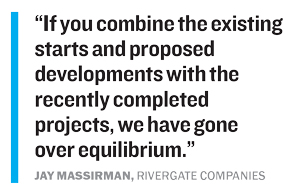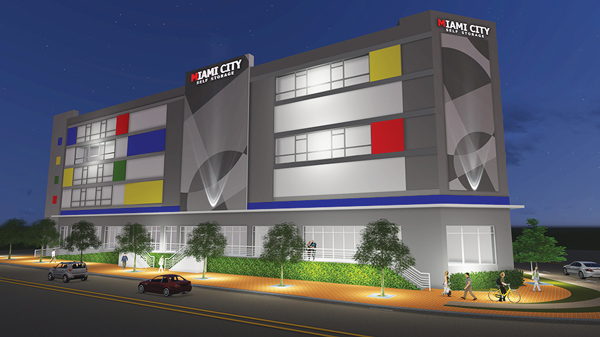Gone are the days when self-storage facilities consisted of drab, one-story buildings tucked away in remote areas of Miami-Dade, Broward and Palm Beach counties. New facilities are going vertical and popping up in densely populated urban areas such as Miami’s Brickell neighborhood and the city of Doral. And developers and investors are willing to put up tens of millions of dollars to get into the game, pushing a wave of new construction and big-ticket acquisitions of ultramodern warehouses.
Steven Wasserman, an executive vice president in Colliers International’s Fort Lauderdale office, said self-storage buildings have become attractive investment opportunities due to several factors. “There are limited tenant improvements and limited property management needs, and the cash flow is very consistent,” Wasserman said. “Unlike an office building, there is not a lot of need for infrastructure or tenant improvements. It’s just four walls with an overhead door.”
South Florida’s growing population, as well as retirees downsizing from single-family homes to condo units, has created more demand for self-storage facilities, Wasserman said. “With all the new condo construction along the beach and Intracoastal communities, empty-nesters moving into these buildings won’t have a garage to put their stuff in,” Wasserman said. “These storage units are relatively inexpensive to lease as well, going for $25 to $75 per month.”
For owners of self-storage facilities, the profit margins are very healthy, Wasserman added. “If it is built in an area with high barriers [to entry], the return can be 5 to 6 percent,” he said. “If it is in a good location, your returns can be as high as 8 to 10 percent.”

Nationally, self-storage facilities have been outperforming all other major commercial property types in terms of earnings growth and company stock performance, according to a Green Street Advisors analysis. In November 2017, the annualized rate of new self-storage construction was $4.6 billion on a seasonally adjusted basis — double that of November 2016 and triple that of November 2015, the report found.
But there is a sign of weakness in the sector, as public self-storage companies are trading at a 2 percent discount to the estimated market value of the properties they own, per the Green Street research. However, it’s still better than office and mall real estate investment trusts, which are trading at 9 and 13 percent discounts, according to the report.
The promise of big gains has turned self-storage facilities into a hot asset class in South Florida, as some recent trades show. In September, a Prudential real estate investment trust bought a 101,000-square-foot self-storage building in Miami’s Little Havana neighborhood for $18.5 million. The previous owner, former candy magnate Bruce Weiner, spent a combined $10.9 million in acquiring the site and building the four-story structure at 641 Northwest 12th Avenue.
The same month, Value Store It — a self-storage company with operations in Miami-Dade and Massachusetts — acquired a 76,236-square-foot-facility in Pompano Beach for $10 million, or $130 per square foot. The seller, GT Development, paid $1.6 million for the land in 2006 and completed the building in 2010.
In November, Atlanta-based Mequity Companies bought a development site in Little Havana for $2.3 million and obtained a $20.17 million construction loan to build an eight-story self-storage building with 1,152 units. The building will be managed by national self-storage company CubeSmart, which is also making its own big acquisitions. In December, CubeSmart purchased a 132,000-square-foot facility at 3195 South Congress Avenue in Delray Beach for $17.75 million. Seller Kaufman Lynn Construction paid $3.2 million for the 3-acre site and spent another $11 million building the six-story self-storage facility on the property.
A month later, a partnership between former Related Companies executive Zain Koita and former BBH Capital Partners private equity analyst Matt Sprayregen obtained $13.75 million in financing to build a 120,000-square-foot, five-story self-storage facility at 7865 Northeast 10th Avenue in Miami.

Steve Wasserman
Jay Massirman, managing principal of Coconut Grove-based commercial developer Rivergate Companies, said 10 years ago that private equity firms and publicly traded insurance companies did not consider self-storage buildings a large asset class. “Now, as population continues to grow in more urban cities like Miami, it is not overlooked anymore,” Massirman said. “People are seeing that the returns are pretty decent.”
He said he saw the potential in self-storage development in 2013. His firm partnered with national REIT SJM Partners to form Miami City Self Storage. “Because of the fair amount of distress between 2009 and 2012, the major companies like Public Storage and ExtraSpace had gotten out of the business of building new facilities,” Massirman said. “They figured it would be cheaper to buy a building, which also eliminated construction debt on their balance sheets.”
In November, Miami City Self Storage opened two new storage buildings with a combined 150,900 square feet of space in Miami’s Wynwood and Upper East Side neighborhoods. The joint venture also has eight self-storage facilities totaling 697,727 square feet under construction in Miami-Dade and Broward. The combined cost of construction is $126.9 million. Massirman said those facilities will be finished this year.
Yet he believes South Florida is reaching a self-storage saturation point. “South Florida, for all intents and purposes, is done,” Massirman said. “If you combine the existing starts and proposed developments with the recently completed projects, we have gone over equilibrium.”
Colliers’ Wasserman said overdevelopment of self-storage facilities is making it harder for developers and institutional investors to find land to build on. “If you are lucky enough to get a good site, the cost of building from the ground up is getting very expensive,” Wasserman said. “That’s why entrepreneurs and REITs prefer to buy an existing warehouse in a good location.”
Wasserman noted that once public companies and institutional investors acquire a self-storage facility, they are not looking at it as a short-term investment.
“They will hold on to it for a long time,” he said. “Generally, you are not buying it for the flip because the cash flow is so sweet.”
